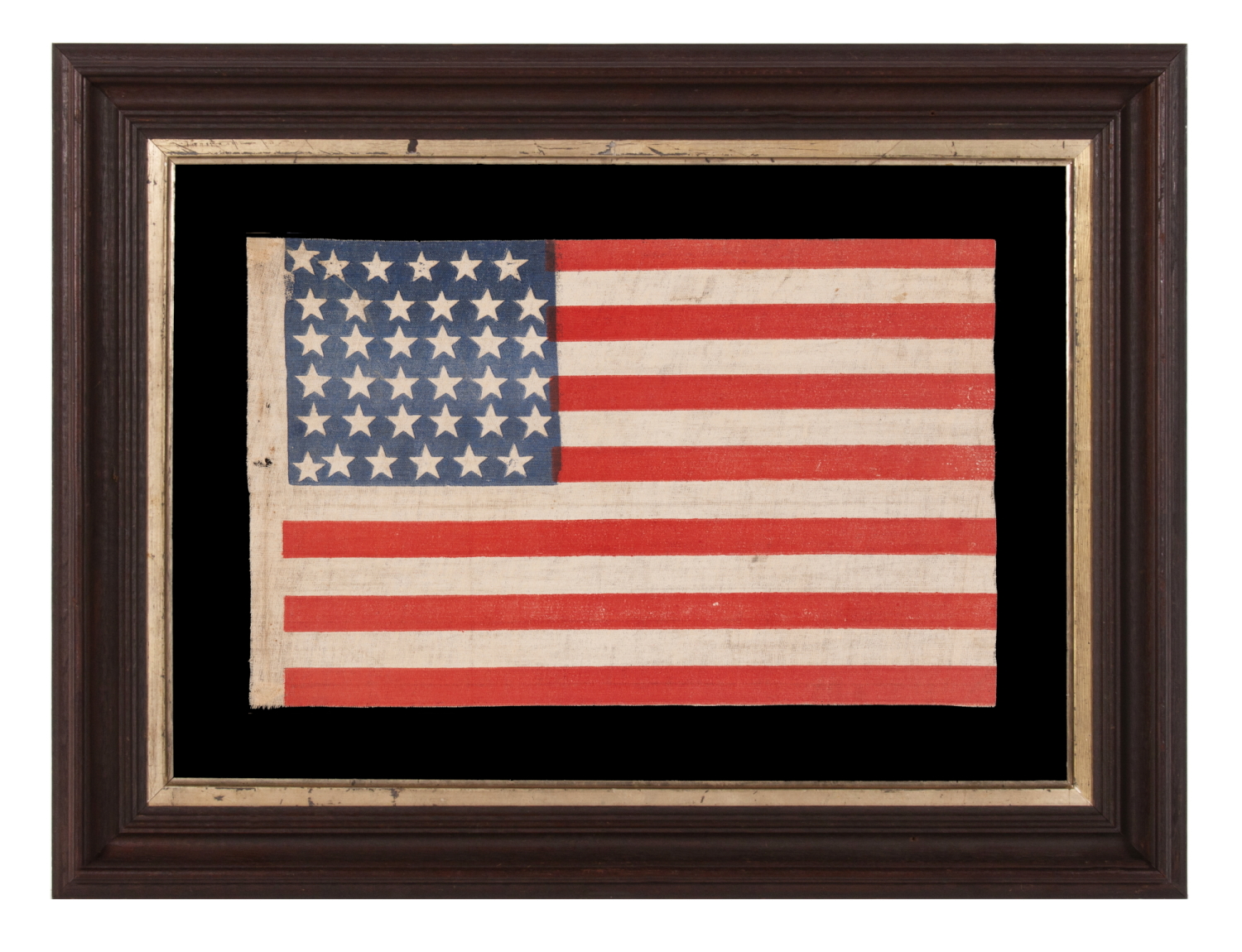
| |
36 STAR FLAG OF THE CIVIL WAR ERA WITH AN EXTREMELY SCARCE STAR CONFIGURATION THAT DISPLAYS A “U” FOR UNION, NEVADA STATEHOOD, 1864-1867 |
|
| Available: |
Sold |
| Frame Size (H x L): |
21.75" x 28.5" |
| Flag Size (H x L): |
11.5" x 18.25" |
|
| Description....: |
|
36 Star, Civil War era (1864-67) American parade flag, printed on cotton, with a lineal star configuration that is framed on three sides by a “U” for "Union". This is one of a highly interesting group of known flags that display such imagery that relays a subtle, Civil War message. Similar designs are known in other star counts, including 34 and 13 stars (also Civil War period), but all are rare. This particular flag is one of a small handful of examples that I have encountered in this style.
Interestingly enough, this flag—and other known styles in the 1860’s to 1870’s era—probably came about simply as modifications of an earlier arrangement of fewer stars. Parade flags such as this one were block-printed onto fabric, usually by way of a carved wooden pattern, sometimes overlain with leather or felt to absorb the pigment into which it was dipped. Because new states entered the Union at a rather fast pace, some flag-makers found it more practical to modify an existing print block than to make an entirely new one. In the case of this particular variety, two additional stars, located at the extreme upper and lower corners of the hoist end, were added to a previous carving of 34 stars in relief, so that no pigment would adhere in these areas and the design would be updated to 36 stars. So the reason for making the pattern had a practical purpose first and perhaps symbolic purpose second.
This star pattern is also closely related to a group of known configurations that depict what I have termed a "beehive". The design can be seen in this instance if the flag is rotated counterclockwise 90 degrees. Though rare in antique American flags, this configuration seems to have been intentional in a handful of Civil War and post-war flags. This was a time where lots of symbolism can be found in the Stars & Stripes, by passionate Americans who had liberty to do what they wished with flag design. A common Masonic symbol, the beehive represents hard work and industry and is frequently encountered in fraternal objects. It is also seen in early America on paper currency and printed ephemera, as well as state and federal seals and patriotic textiles. It was a seeming accurate representation of colonists' ideals and likewise supported the notion that if united together, the colonies could accomplish more than they could as individual entities.
Lincoln pushed Nevada through to statehood on October 31st, 1864, during the Civil War, and just 8 days before the November election. The territory’s wealth in silver was attractive to a nation struggling with the debts of war and so increased support for the Republican ticket. While the 36th star wasn't officially added until July 4th of the following year, the makers of printed flags are known to have begun adding the 36th star as early as July of 1864, several months before the addition of Nevada actually occurred. This was a common practice during the late 19th century and is reflective of both the nation's desire for Westward Expansion and the hope of flag-makers to bring new star counts to market before their competitors. The 36 star flag was officially replaced by the 37 star flag in 1867, following the addition of Nebraska.
It is of interest to note that the white fabric used to create this particular style of parade flag was printed first with white pigment, probably so it was whiter then the cotton and so that the blue and red pigments would adhere better. This variety was also printed on both sides, which is extremely unusual. Almost all parade flags were printed on one side only, and the color would instead bleed through to the other side to create a two-sided flag.
Mounting: The flag was mounted and framed within our own conservation department, which is led by expert staff. We take great care in the mounting and preservation of flags and have framed thousands of examples.
The solid walnut frame dates to the period between 1860 and 1870, and so is period to the flag. It has a very attractive profile, original surface, and retains its original gilded liner. The background is 100% cotton twill, black in color. The glazing is U.V. protective.
Condition: There is minor misprinting and pigment loss. There are tack holes and some soiling along the hoist, where the flag was once attached to its original wooden staff. Many of my clients prefer early flags to show their age and history of use. |
|
|
|
| Collector Level: |
Advanced Collectors and the Person with Everything |
|
| Flag Type: |
Parade flag |
|
| Star Count: |
36 |
|
| Earliest Date of Origin: |
1864 |
|
| Latest Date of Origin: |
1867 |
|
| State/Affiliation: |
Nevada |
|
| War Association: |
1861-1865 Civil War |
|
| Price: |
SOLD |
|
| |
Views: 329 |
|
|
|

